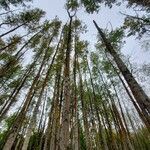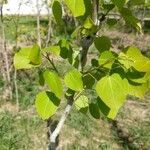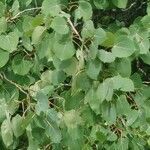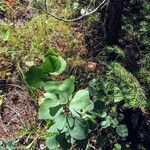Plants to 35 m, 10 dm diam.; moderately heterophyllous. Bark dark gray, shallowly furrowed only basally on large trees, (greenish or yellowish white to gray and smooth otherwise). Branchlets reddish brown, becoming grayish yellow by third year, round, 1.2-3.5(-5) mm diam., coarse or not, glabrous. Winter buds reddish brown, glabrous, (shiny), slightly resinous; terminal buds (2.5-) 4-6(-9) mm, (glabrous); flowering buds separated on branchlets or clustered distally, (4.5-)6-10(-11) mm. Leaves: petiole distally flattened at right angle to plane of blade, (0.7-)1-6 cm, about equaling blade length; blade somewhat circular to ovate, (1-)3-7(-12) × (0.5-) 3-7(-10.5) cm, w/l = ca. 1, base shallowly cuneate to subcordate, shouldered, basilaminar glands (0 or) 1 or 2, round, margins not translucent, not ciliate, apex acuminate to acute, abaxial surface whitish green, resin stains not obvious, (slightly glaucous), glabrous, adaxial dark green, glabrous; preformed blade margins subentire to finely crenate-serrate throughout, teeth (12-)18-30(-42) on each side, sinuses 0.1-1 mm deep, (surfaces glabrous or sparsely sericeous); neoformed blade margins finely crenate-serrate throughout, teeth (20-)25-40(-50) on each side, sinuses 0.1-1.3 mm deep. Catkins densely (20-)50-65(-130)-flowered, (1.7-)4-7(-12.5 in fruit) cm; floral bract apex deeply cut, ciliate. Pedicels 0.5-1.5(-2 in fruit) mm. Flowers: discs narrowly cup-shaped, obviously oblique, entire, 1.3-1.8(-3 in fruit) mm diam.; stamens 6-12; anthers truncate; ovary 2-carpelled; stigmas 2, filiform, basal lobes expanded, erect. Capsules narrowly ovoid, (2-) 2.5-4.5(-7) mm, glabrous, 2-valved. Seeds (3-)5-7(-9) per placenta. 2n = 38, 57, 76.
More
Tree with light grayish-green smooth bark, becoming dark and furrowed in age; petioles strongly flattened; terminal buds brown, shining, glabrous or nearly so; lvs glabrous, dark green above, light green and slightly glaucous beneath, without basal glands, 3–10 cm, rotund-ovate to reniform-cordate, shortly acuminate to merely apiculate, the lowest lateral veins strongly ascending; lvs of short shoots finely and regularly toothed, with mostly 18–30 teeth to 1 mm deep on each side, those of the long shoots often with even smaller and more numerous teeth, or subentire; scales of the catkins cleft to below the middle into 3–5 lance-triangular lobes; stamens, stigmas, and frs much as in no. 2 [Populus grandidentata Michx.]; 2n=38, 57, 76. Moist upland woods and streamsides, often on cut-over or burned land; Lab. to Alas., s. to N.J., Va., Tenn., Mo., and Mex.
A tree which loses its leaves. It grows 25-30 m high. The bark is yellow. It is light and smooth but becomes rough and dark grey at the base of the tree. Young branches are reddish-brown. They are smooth and easily broken. The buds are sticky. The leaves are finely toothed. They are alternate and rounded or heart shaped and pointed. The leaf stalk is long and flattened at the side.





